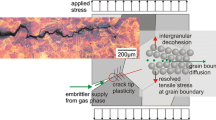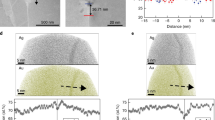Abstract
This paper reviews the evidence for an adsorption-induced dislocation-emission (AIDE)/void-coalescence mechanism of liquid-metal embrittlement (LME), hydrogen embrittlement (HE), stress-corrosion cracking (SCC), and corrosion fatigue (CF) in some specific material-environment systems, where cleavage-like or intergranular cracking (or both) occurs in normally ductile materials. Embrittling species (which weaken substrate interatomic bonds at crack tips) include some metal atoms, hydrogen (on the crack-tip surface and at very-near-surface interstitial sites), and complex ions produced by de-alloying. Decohesion due to bond-weakening across grain boundaries associated with adsorbed or segregated hydrogen, in conjunction with segregated impurities, may also occur in some systems. The often-cited hydrogen-enhanced localised-plasticity (HELP) mechanism, based on solute hydrogen facilitating dislocation activity in the plastic zone ahead of cracks, appears to play little (if any) role in cleavage-like and intergranular cracking, and evidence supporting this view is summarised.
Zusammenfassung
In diesem Beitrag werden die Hinweise auf eine Adsorptionsinduzierte Versetzungsemission (AIDE)/Fehlstellen-Koaleszenz-Mechanismus bei der Flüssigmetall-Versprödung (LME), der Wasserstoffversprödung (HE), der Spannungsrisskorrosion (SCC) und der Korrosionsermüdung (CF) in einigen spezifischen Material-Umwelt-Systemen untersucht, in denen Quasi-Spaltbruch oder interkristalline Rissbildung bei normalerweise duktilen Werkstoffen auftreten. Zu den versprödenden Spezies, welche die interatomaren Bindungen an Rissspitzen schwächen, gehören einige Metallatome, Wasserstoff (auf der Rissspitzenoberfläche und an sehr oberflächennahen Zwischengitterplätzen) und durch Legierungsauflösung produzierte Komplexionen. Dekohäsion aufgrund von Bindungsschwächung über Korngrenzen verbunden mit adsorbiertem oder getrenntem Wasserstoff, in Verbindung mit geseigerten Verunreinigungen, kann auch in einigen Systemen auftreten. Der oft zitierte Wasserstoff-unterstützte lokalisierte Plastizitäts-Mechanismus (HELP), der darauf basiert, dass gelöster Wasserstoff in der plastischen Zone vor der Rissspitze die Versetzungsbewegung erleichtert, scheint wenig (wenn überhaupt eine) Rolle bei Quasi-Spaltbruch oder interkristalliner Rissbildung zu spielen. Argumente für diese Sicht werden zusammengefasst.
































Similar content being viewed by others
References
Lynch, S. P.: Mechanistic and fractographic aspects of stress-corrosion cracking (SCC), in: Raja, V. S.; T. Shoji, T. (eds.): Stress Corrosion Cracking, Cambridge: Woodhead Publishing Limited, 2011, pp 3–89, republished in: Corrosion Reviews, 30 (2012), pp 63–104
Lynch, S. P.: Hydrogen embrittlement phenomenon and mechanisms, in: Raja, V. S.; T. Shoji, T. (eds.): Stress Corrosion Cracking, Woodhead Publishing Limited, Cambridge, 2011, pp. 90–130, republished in: Corrosion Reviews, 30 (2012), pp 105–123
Lynch, S. P.: Metallographic and fractographic techniques for characterising and understanding hydrogen-assisted cracking, Chapter 9, in: Gangloff, R. P.; Somerday, B. P. (eds): ‘Gaseous Hydrogen Embrittlement of Materials in Energy Technologies’, Vol. 1, Cambridge: Woodhead Publishing Limited, 2011, pp. 274–346
Lynch, S. P.: Mechanisms and kinetics of environmentally assisted cracking: Current status, Issues, and suggestions for further work, Metall. and Mater. Trans. A, 44 A (2013), pp 1209–1229
Lynch, S. P.: Failures of structures and components by metal-induced embrittlement, J. Fail. Anal. and Preven., 8 (2008), pp.259–274, 2008, republished in: Raja, V. S.; Shoji, T. (eds.): Stress Corrosion Cracking, Cambridge: Woodhead Publishing Limited, 2011, pp 714–748
Plinius Secundus, C. (or Pliny): “The History of the World commonly called The Natural History”, translated by P. Holland, McGraw-Hill, 1964, pp 364–365
M. H. Kamdar, M. H.: Embrittlement by Liquid Metals, Progress in Materials Science, 15 (1973), pp 289–374
Robertson, I. M.; Sofronis, P.; Nagao, A.; Martin, M. L.; Wang, S.; Gross, D. W.; Nygren, K. E.: Hydrogen Embrittlement Understood, Metall. and Mater. Trans. A, 46 A (2015), pp 2323–2341, 2015, and references therein
Wei, W.: Crack Kinetics in the Nickel-Hydrogen System, Ph. D. Thesis, University of Illinois at Urbana-Champaign, 1984
Vehoff, H.; Rothe, W.: Gaseous hydrogen embrittlement in FeSi- and Ni-single crystals, Acta Metall., 31 (1983), pp. 1781–1793
Teter, D. F.; Robertson, I. M.; Birnbaum, H. K.: The effects of hydrogen on the deformation and fracture of β-titanium, Acta mater., 49 (2001), pp 4313–4323
Barnes, A.; Senior, N. A.; Newman, R. C.: Film-induced cleavage of Ag-Au alloys, Metall. and Mater. Trans. A, 40 A (2009), pp 58–68
Flanagan, W. F.; Lichter, B. D.: A mechanism for stress-corrosion cracking, International Journal of Fracture, 79 (1996), pp 121–135
Author information
Authors and Affiliations
Corresponding author
Rights and permissions
About this article
Cite this article
Lynch, S. Understanding Mechanisms and Kinetics of Environmentally Assisted Cracking. Berg Huettenmaenn Monatsh 161, 3–18 (2016). https://doi.org/10.1007/s00501-016-0448-8
Received:
Accepted:
Published:
Issue Date:
DOI: https://doi.org/10.1007/s00501-016-0448-8




